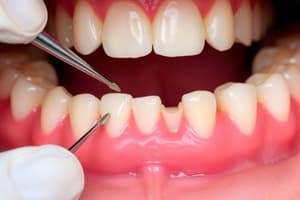Podcast
Questions and Answers
What does a negative number indicate when determining the level of free gingival margin in relation to the CEJ?
What does a negative number indicate when determining the level of free gingival margin in relation to the CEJ?
Which statement correctly describes Clinical Attachment Level (CAL)?
Which statement correctly describes Clinical Attachment Level (CAL)?
What distinguishes gingivitis from periodontitis in clinical evaluations?
What distinguishes gingivitis from periodontitis in clinical evaluations?
In which situation would you observe a positive number when measuring the free gingival margin?
In which situation would you observe a positive number when measuring the free gingival margin?
Signup and view all the answers
What is necessary for calculating Clinical Attachment Level (CAL)?
What is necessary for calculating Clinical Attachment Level (CAL)?
Signup and view all the answers
What does probing depth measure?
What does probing depth measure?
Signup and view all the answers
Why is the diameter of the periodontal probe important?
Why is the diameter of the periodontal probe important?
Signup and view all the answers
Which of the following is NOT a component when undertaking the six point pocket chart?
Which of the following is NOT a component when undertaking the six point pocket chart?
Signup and view all the answers
What is the relevance of Clinical Attachment Level in periodontal assessment?
What is the relevance of Clinical Attachment Level in periodontal assessment?
Signup and view all the answers
What is a limitation of periodontal probing?
What is a limitation of periodontal probing?
Signup and view all the answers
How is the free gingival margin measured?
How is the free gingival margin measured?
Signup and view all the answers
Which area is not part of the six point pocket chart?
Which area is not part of the six point pocket chart?
Signup and view all the answers
Which of the following statements is true regarding the six point pocket chart?
Which of the following statements is true regarding the six point pocket chart?
Signup and view all the answers
Study Notes
Periodontal Probing
- Probing depth is the distance from the gingival margin to the bottom of the pocket.
- The probing depth is measured with a periodontal probe having a standard tip diameter (0.4mm to 0.5mm).
- Probe diameter affects the accuracy of the measurement.
- Limitations of probing: includes difficulties with adaptation, angulation, and walking.
Six Point Pocket Chart
- The six point pocket chart is used for pre-treatment periodontal assessments.
- The six points correspond to specific locations around the tooth:
- Distobuccal line angle to midline of distal surface
- Buccal surface
- Mesiobuccal line angle to mesial surface
- Distolingual line angle to distal surface
- Lingual surface
- Mesiolingual angle to midline of mesial surface
- Issue with Six Point Terminology: There is a potential for double-measuring the same site.
Free Gingival Margin
- The free gingival margin is the level of the gingiva relative to the cemento-enamel junction (CEJ).
- Natural position: The gingival margin slightly covers the CEJ.
- Apical to CEJ: Charted as a positive (+) number, indicating recession.
- Coronal to CEJ: Charted as a negative (-) number, indicating the gingival margin covering the CEJ.
Clinical Attachment Levels (CAL)
- CAL measures the true attachment of the tooth to the surrounding tissue.
- CAL provides an indication of the periodontal support around a tooth.
- CAL is measured from the CEJ, a fixed reference point.
- CAL helps differentiate between gingivitis (inflammation without attachment loss) and periodontitis (inflammation with attachment loss).
Calculating CAL
- Requires probing depth and the level of the gingival margin.
- Formula for CAL: CAL = Probing Depth + (Level of Free Gingival Margin relative to CEJ).
Studying That Suits You
Use AI to generate personalized quizzes and flashcards to suit your learning preferences.
Related Documents
Description
This quiz covers key concepts in periodontal probing, including the measurement of probing depth, limitations associated with probing techniques, and the six-point pocket chart used for periodontal assessments. Understanding the free gingival margin is also discussed, highlighting its relevance in periodontal evaluations.




